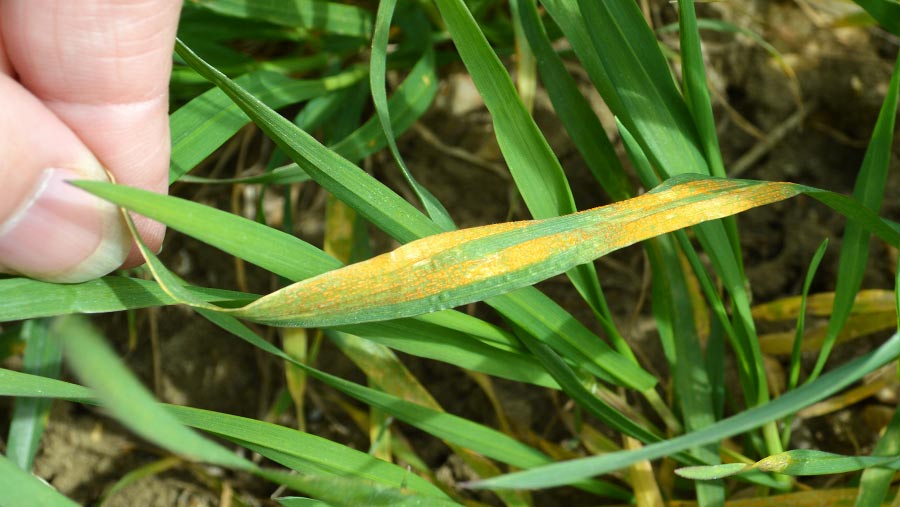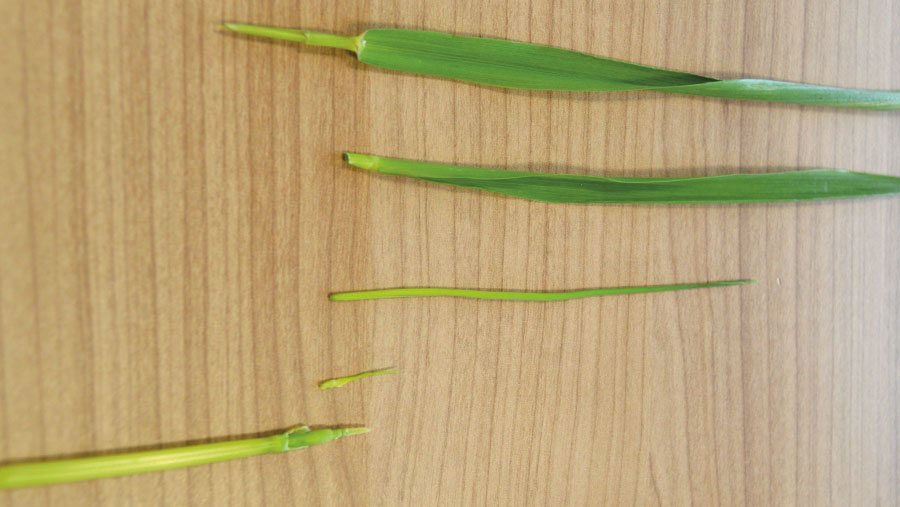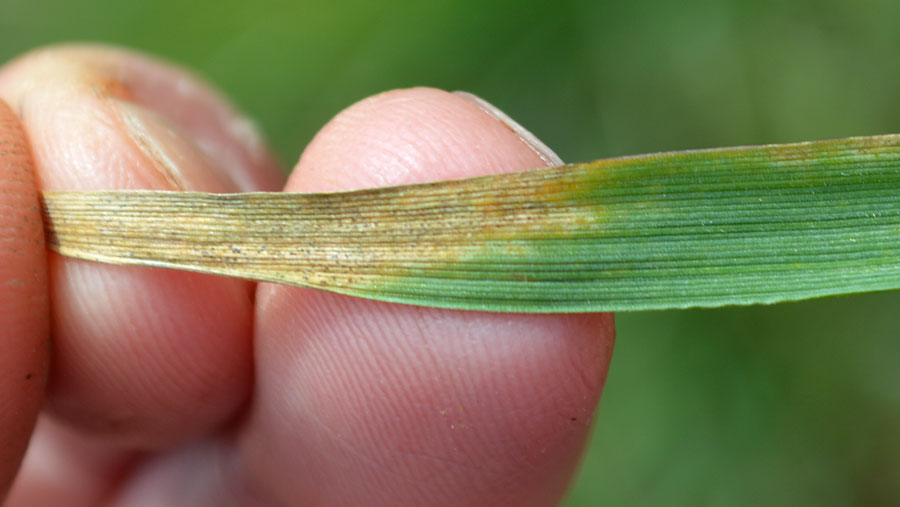How to save up to £50/ha on your wheat fungicide programme
 Yellow rust in wheat
Yellow rust in wheat Wheat growers could be saving up to £50/ha on fungicide costs by using the latest more disease-resistant varieties coupled with late drilling in the autumn.
Choosing varieties such as Graham, Sundance, Illustrious and Extase, growers may need only two fungicide sprays per season rather than the more common four-spray programmes.
Bill Clark, technical director at crop consultant Niab, says these varieties are as high-yielding as other popular more disease-susceptible ones and can be less risky to grow.
“There are big potential savings in terms of fungicide use by growing these varieties and not increasing your risk,” he tells Farmers Weekly.
See also: Why wheat variety data is vital for right fungicide strategy
Fungicide requirements
He divides the winter wheat varieties on the current AHDB Recommended List into three – high, moderate and low inputs – in terms of fungicide requirements.
The low input group ranging from Bennington to Extase are all high-yielding varieties, show a relatively low response to fungicides due to their good disease resistance and are resilient to grow.
Wheat growers could be spending £70-80/ha on fungicides for this low-input group compared with £100/ha for the moderate-input group and £120/ha for the high-input group, he says.
These figures assume a mid-October drilling date, while the disease risk will vary according to location, with the drier east of the country likely to be less risky to cut fungicide use than the wetter west.
“These low-input varieties can reduce the risk of growing a crop, as if growers get a fungicide timing wrong the yield penalty is low,” he says.
The picture below shows (top to bottom): leaf four, leaf three, leaf two, leaf one or flag leaf and the wheat ear.

Two-spray strategy
For these low-input varieties he suggests using a three-spray programme (see table), but if growing feed varieties growers may be able to cut out a T3 head spray, often used to protect the milling quality of breadmaking varieties, and opt for a two-spray strategy.
This group of varieties has the best genetic resistance to wheat’s most damaging disease, septoria, with Extase rated 8.1, Sundance 7.9 and Graham 6.9 on a scale of 1-9 where 1 is very susceptible while 9 represents good resistance.

Septoria in wheat
Some of the varieties with the lowest septoria scores, such as Elation 4.3, Barrel 4.5, Leeds 4.6, Viscount 4.8 and Jackal 4.9, are in the high fungicide input group.
The low-input varieties also tend to have good resistance to wheat’s second biggest disease threat, yellow rust, with Extase, Sundance and Illustrious all 9s, and at the other end of the scale Myriad and Diego are 4s.
Potential yield loss
He highlights that with the variety Extase, if a grower is a week late with a T1 fungicide then it is less important than for a disease-susceptible variety as the potential yield loss with Extase is well below that of Myriad.
This is because the yield response to using fungicide with Extase is relatively small, at 0.69t/ha, while with Myraid it is a whopping 3.85t/ha.

Bill Clark
But whereas fungicide timing is less critical for Extase, timing for the 70% of the national crop in moderate- and high-input groupings of varieties is absolutely critical.
“For the these two groups, timing is everything, and timing is more important that fungicide product choice,” he adds.
Using one of Niab’s on-line tools and plugging in a feed wheat price of £160/t then the optimum margin for Extase comes from spending half the fungicide cost compared with the old disease-susceptible variety Santiago, now removed from the list.
Best margins
In a low-risk situation with Extase, the best margins comes from spending £66/ha which could be made up of a T1 of chorothalonil + azole and a T2 of SDHI + azole + chlorothalonil, and with no T0 or T3.
For comparison, in a high-risk disease situation with Santiago the seasonal fungicide programme would cost about £130/ha.
The use of one SDHI in a season, as with the programme for Extase, will also help with resistance management at a time when growers face the loss of more and more fungicides.
The European Union has moved to ban the widely-used multisite protectant fungicide chlorothalonil as it failed to meet the EU’s toxicity test, and after a use-up period the product is probably not going to be available after summer 2020.
Growers also face the likely loss of the widely used azole epoxiconazole, as used in products such as Adexar, while the popular T0 product Cherokee is in a use-up period after being banned.
Variable yield
Returning to Extase, Mr Clark points out that although the variety is high yielding and relatively unresponsive to fungicides, there is greater variable in its untreated fungicide yield compared with other varieties in this group such as Graham, Sundance, Siskin and Zyatt.
In the moderate-input group, including Skyfall, Shabras and Costello, if growers have missed a T0 due to the dry spring weather then the timing of the T1 spray becomes even more important.
The T1 stage is often described when three-quarters of leaf 3 has emerged on the main stem (see photograph of winter wheat plant dissection), and this often appears in the latter half of April, or even into May further north in the country.
High-input group |
||
| Variety | Yield response (t/ha) | Fungicide requirement |
| Myriad | 3.85 |
T0 chlorothalonil T1 chlorothalonil + high dose SDHI + azole T2 chlorothalonil + high dose SDHI + azole T3 azole |
| Leeds | 3.45 | |
| Barrel | 3.26 | |
| Diego | 3.19 | |
| Lili | 3.16 | |
| Zulu | 2.92 | |
| Jackal | 2.87 | |
| Basset | 2.86 | |
| Gravity | 2.73 | |
| Viscount | 2.69 | |
| Detroit | 2.63 | |
| Elation | 2.62 | |
| Crusoe | 2.54 | |
| Kerrin | 2.51 | |
Moderate-input group |
||
| Variety | Yield response (t/ha) | Fungicide requirement |
| Skyscraper | 2.49 |
T0 chlorothalonil T1 chlorothalonil + moderate dose SDHI +azole T2 chlorothalonil + high dose SDHI + azole T3 azole |
| Trinity | 2.39 | |
| Shabras | 2.39 | |
| Spotlight | 2.38 | |
| Evolution | 2.29 | |
| Elicit | 2.1 | |
| Gleam | 2.1 | |
| Skyfall | 2.04 | |
| Costello | 2.01 | |
Low-input group |
||
| Variety | Yield response (t/ha) | Fungicide requirement |
| Bennington | 1.99 |
No T0 T1 chorothalonil + azole T2 chlorothalonil + moderate dose SDHI + azole T3 azole |
| Revelation | 1.97 | |
| Crispin | 1.97 | |
| Siskin | 1.89 | |
| Firefly | 1.82 | |
| Motown | 1.78 | |
| Sundance | 1.75 | |
| Dunston | 1.64 | |
| Zyatt | 1.62 | |
| Graham | 1.61 | |
| Illustrious | 1.61 | |
| Extase | 0.69 | |
Disease rating for selected winter wheat varieties |
|||
| Variety | Septoria | Yellow rust | Brown rust |
| Low-input group | |||
| Extase | 8.1 | 9 | 7 |
| Sundance | 7.9 | 9 | 6 |
| Graham | 6.9 | 8 | 6 |
| Moderate-input group | |||
| Skyfall | 5.9 | 5 | 8 |
| Shabras | 6.2 | 7 | 5 |
| Costello | 6.1 | 9 | 5 |
| High-input group | |||
| Myriad | 5.6 | 4 | 6 |
| Diego | 5.2 | 4 | 6 |
| Leeds | 4.6 | 6 | 7 |

